What a surprise! Once again, I’m introducing a new feature from the Searchmetrics Suite and one that I’m very much looking forward to working with when it finally goes live today. And, it’s all about analyzing subdirectories and subdomains using the Quick Analysis database.
 Why is this so important? I’ll explain that in a minute. But first, a caveat: for this analysis to be truly sensible and useful, you need to take a real good look at the site that you are considering. The results are only reliable if the entries in the website’s directory are well organized and if there is no duplicate content. But of course, if you are reading this blog you have perfectly organized content. Right?
Why is this so important? I’ll explain that in a minute. But first, a caveat: for this analysis to be truly sensible and useful, you need to take a real good look at the site that you are considering. The results are only reliable if the entries in the website’s directory are well organized and if there is no duplicate content. But of course, if you are reading this blog you have perfectly organized content. Right?
Real competition analysis for topical pages
Subdomain and directory analysis allows you to focus on your vertical markets and topical visibility so that you are looking apples to apples at your competitors. For some larger industries, it’s hard to do a competitive analysis without narrowing down to a specific category. Large companies will often have different competitors in different verticals.
Currently in the ‘auto’ sector – besides the ‘usual suspects’ like auto-motor-and-sport.de and autobild.de – there are, of course, the sometimes quite successful and strong vertical ‘auto’ categories from Spiegel, Focus, and T-Online. Spiegel and Focus use directories, while T-Online works with a subdomain. And this is precisely where the competition overview in the quick analysis is helpful:

And indeed, this looks much better for the special interest magazine than the general ‘domain’ comparison. It is also interesting to compare the SERP spreading for these four sites:

Oooops. T-Online seems to be doing considerably worse in comparison with its competitors. This could be due to less attention directed toward the auto.t-online.de subdomain. Either way, we can quickly recognize how the market appears in the overview.
Obviously, analysis based on directories and subdomains also provides good insight into the inner structure of a site – without which it would feel like an insurmountable mountain. Let’s look at Spiegel Online. In the image (click to enlarge), we can see the visibility of the strongest categories and satellites.
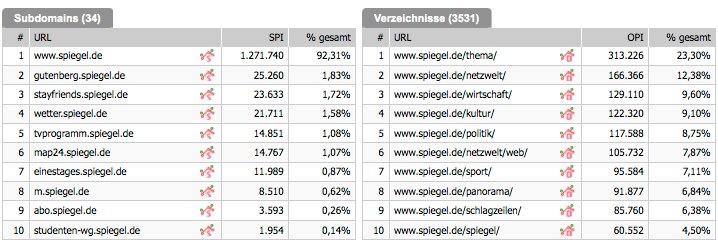
Of course, you should also zoom-in a little and analyze the most important categories over time. First, take note of the introduction of the topical pages (red arrow). And – independently from this – the red curve (video channel, yellow arrow) is also quite noteworthy:
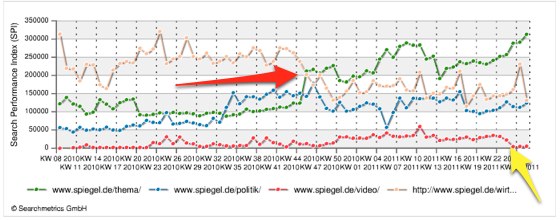
What happened here? I think we can forget link building as a reason, so take a look at archive.org and see whether anything else grabs your attention…
In fact, the story has another dimension: in total, Spiegel Online did not win at all – in reality, the win for the special topic pages came at the expense of other areas like politics and the economy. And those who know the topic pages, know exactly why this is.
And one more little thing – it seems like the videos are not on their way to a happy ending, as can be seen with the significant losses due to Universal Search video integration. Of course, this can also be directly compared in the Quick Analysis.
And so! Now we have our first blog entry with a workshop element. As a simple exercise, I’ve included an image of two categories from ciao.de. The task: “In 10 minutes, identify the backgrounds of these two curves and summarize them briefly.
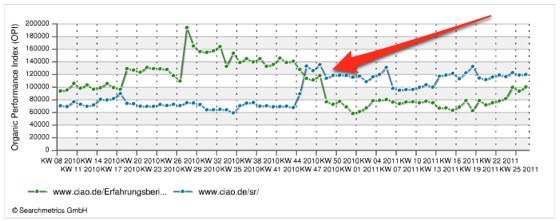
It’s not so hard. Have fun finding the answers 😉
Oh, and finally a little more about ‘Panda’
While I’m telling stories – I put together the following image from the US index of two directories from Panda-losers answers.com:

We don’t need long to work out what happened here – the wiki.-subdomain took the worst of it rather than the www.- subdomain. However, this too was trimmed by the so-called Panda 2.2 Update.
Finally, we’ll take another quick look at the SERP spreading for both of these subdomains – for today:
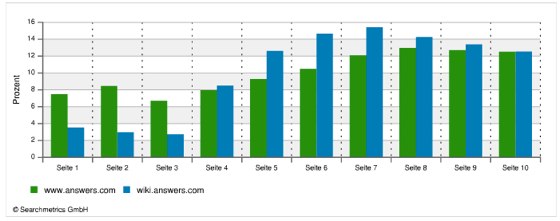
And once again, from January 2011, before Panda ruled over at Google:
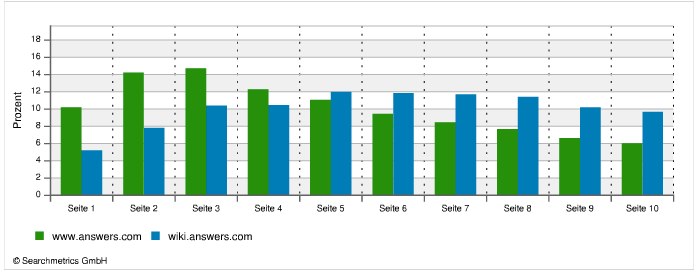
Not exactly a surprise either, but I just wanted to show firstly that the first Google penalties (if you can call the Panda Update such a thing for answers.com) were quite happy to treat subdomains differently. And secondly, that you can track them only with a detailed analysis of overall site structure.
P.S.: Who’s writing this stuff? My name is Eric Kubitz and I am one of the co-founders of CONTENTmanufaktur GmbH Anyone trying to reach me can do so via e-mail (ek@contentmanufaktur.net) or on Twitter. ‘Til next time!